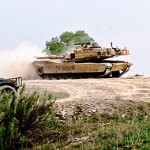Saving the soil
August 2010
AgriLife units work to improve training terrain
Story by Melanie Orth
Heavy tanks and armored vehicles that have continually rolled over the 67,000-acre West Range at Fort Hood
for the past 60 years have accelerated soil erosion. Fort Hood, the largest active duty armored post in the U.S. Armed Services and located near Killeen in central Texas, uses the range as the primary training and maneuver area for two armored divisions.
The Texas Water Resources Institute and Texas AgriLife Blackland Research and Extension Center are working to improve the training terrain. The units are collaborating with the U.S. Department of Agriculture’s Natural Resources Conservation Service (NRCS) and Fort Hood’s Integrated Training Management and Directorate of Public Works on two projects:

- the Fort Hood Range Revegetation Pilot Project
- the Fort Hood Training Lands Restoration and Maintenance Project.
Dr. Bill Fox, assistant professor at Blackland, said the main objectives of these projects are to help maintain quality training lands for soldiers and other military personnel, maintain and improve the natural resource base, protect the surrounding watersheds, and improve the water quality of supply reservoirs.
The revegetation project began in 2003, and project members started evaluating the addition of composted dairy manure to primary training areas as a management practice. Compost enhances soil quality and promotes vegetative growth, Fox said. Thus far, about 25,000 tons of composted dairy manure from the impaired North Bosque River Watershed have been applied to more than 2,000 acres of training lands at Fort Hood.
Taking compost out of the Bosque River watershed helps relieve that watershed of excess phosphorus found in the manure, Fox said. “Excessive nutrients in one watershed are being used to fertilize nutrient-starved soil in another,” he said. “We have also determined that nutrients in dairy compost under recommended rates do not pose a threat to the water quality of protected watersheds within Fort Hood.”
The project also uses compost in coordination with contour ripping practices. Placing compost and grass seeds over the contour rips helps establish vegetation buffers and reduces runoff and erosion, Fox said. Both the contour ripping and revegetation have reduced stormwater discharge by about 50 percent compared to untreated areas.
The restoration and maintenance project was federally funded in 2007 and works on developing best management practices that effectively control compaction, runoff, erosion, woody species management, tank trail management, and sedimentation. Applying these practices on a representative watershed has reduced erosion by up to 90 percent and stormwater runoff by more than 60 percent, Fox said.
Through both projects, Fort Hood is integrating sound environmental stewardship and improving training conditions for soldiers.
“The U.S. Department of the Army and the U.S. Department of Defense have placed special importance on improving environmental factors that affect these training facilities,” he said. Visit twri.tamu.edu/txH2O to read more about these projects.
